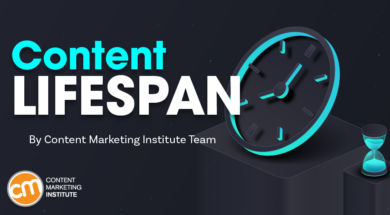 What’s the half-life of news articles these days?
What’s the half-life of news articles these days?
How should that affect your mix of marketing, thought leadership, research, and other news-focused content?
New research from Chartbeat, a content intelligence platform for publishers, sheds light on how positioning, traffic source, topic, and other attributes impact the lifespan of an article.
CMI’s chief strategy advisor Robert Rose explains what the findings mean for your content choices in this week’s CMI News video. Watch it below, or keep reading for the highlights:
How long does it take content to reach 80% of its lifetime views?
Chartbeat looked at 27 million articles across its network, including major media outlets, product and services companies with media, and more. It marked the lifespan of an article as the time it takes to reach 80% of total page views in its first week.
Most news articles reach that 80% within 24 hours of their publication. Almost all have run their course by the 48-hour mark.
As Chartbeat explains, that doesn’t mean the articles won’t attract views in the following days, but it demonstrates how important that first day is.
More interesting (but not surprising) are the effects of traffic sources. Those driven by returning traffic (front-page articles) reached 80% within 20 hours. Articles with views driven by social media traffic reached that number after 26 hours, and search-driven pieces stretched to 36 hours.
And that makes sense. Breaking news hits the front page of a media publication and usually gets consumed quickly. Search-driven articles take time to be indexed and found.
Chartbeat also looked at elements such as topic and time of day to see if an appreciable difference existed. Spoiler alert: They didn’t.
Most news articles reach 80% of their lifetime view within 24 hours, says new research. @Robert_Rose explains if this should change your #content plans. Via @CMIContent Click To TweetContent lifespan lessons for marketing
What do Chartbeat’s findings about an article’s lifespan mean for content practitioners?
Robert says the first takeaway is recognizing this research is all about news-related content. It doesn’t matter if your brand positions the articles as news. If your audience perceives it that way, the content will have an extraordinarily short shelf life.
Take this weekly news package, for example. CMI covers the news – topical ideas – and presents them in a relatively “breaking” article and video. You could say the content is evergreen because we don’t intend to limit the takeaways to the week.
But CMI’s weekly news feature sees a curve in engagement and traffic similar to what Chartbeat researchers found. Almost all of the traffic comes in the first 24 hours.
“It’s intentionally designed that way. It creates an impression that we’re keeping up with the trends and builds trust over time,” Robert explains.
Why is it all that important?
The phenomenon has been known for years. People devalue older content in all formats, particularly thought leadership incorporating research. That thinking prompted removing the dates around content to prolong its lifespan.
Robert wrote this about evergreen content last year: “A timeless piece of content doesn’t automatically mean the content will stand the test of time. And content that stands the test of time isn’t necessarily timeless.”
Evergreen content tip: Timeless #content doesn’t always stand the test of time, says @Robert_Rose via @CMIContent Click To TweetThat’s great bumper sticker advice (though it would need to be stacked on two decks and stretch across the bumper).
What’s the takeaway? You should consciously decide whether you want to publish news and research with a date (we’re in that camp for all research) and/or publish classic, evergreen content meant to stand that test of time. The decision isn’t just about where to put the content on your site. It involves how you create that content.
Robert offers some help. His article on deciding between timeless or evergreen content includes a section on the six attributes timeless pieces share.
The bottom line: You need a mix of news-driven content that spurs immediate attention and clicks and evergreen content that keeps the audience coming back for more.
How do you mix it up? Dating? No date? What’s the lifespan of your news? Share your thoughts in the comments.
HANDPICKED RELATED CONTENT:
Cover image by Joseph Kalinowski/Content Marketing Institute







